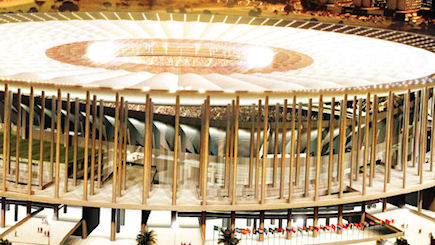This article first appeared in the May/Jun 2014 issue of World Gaming magazine.
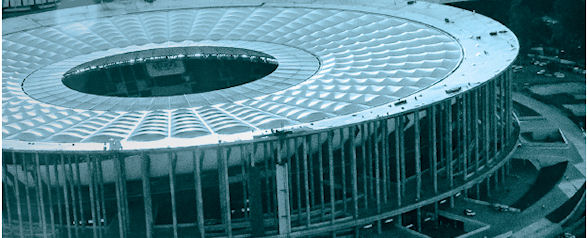
They’ve been rocked by deadly workplace accidents, labor strikes and even a fire at one of them but, despite initial concerns, it looks like Brazil will just about have all stadiums finished and ready to go by the time the World Cup kicks off on 12 June. With US$10.7 billion spent on building and upgrading them, WGM takes a look at the 12 venues for Brazil 2014.
The Maracanã
Rio de Janeiro
Originally built for the last World Cup to be held in Brazil way back in 1950, the famous Maracanã is the largest stadium in South America with a capacity of 78,838 – although it used to be much more with a record 199,854 spectators piling in to watch the 1950 World Cup final between Brazil and Uruguay. A tragic incident in which three people were killed and 50 more injured when a stand collapsed in 1992 led to the stadium being transformed into an all-seater and the capacity greatly reduced. The stadium has been given a major renovation in the lead-up to the World Cup, including the addition of a new fibreglass roof covering 95 percent of seats. It will be the venue for the World Cup final on 13 July.

|
Matches
|
|
| 15 Jun | Argentina v Bosnia-Herzegovina |
| 18 Jun | Spain v Chile |
| 22 Jun | Belgium v Russia |
| 25 Jun | Ecuador v France |
| 28 Jun | Round of 16 – 1C v 2D |
| 04 Jul | Quarter-final – W53 v W54 |
| 13 Jul | Final – W61 v W62 |
Arena de São Paulo
São Paulo
Built by top Brazilian sports club Corinthians to be their home base from 2015, the Arena de São Paulo will eventually have a capacity of 48,234 but due to World Cup guidelines around 21,000 temporary seats have been added to boost the numbers. Set to host the opening match of the tournament between Brazil and Croatia, organizers suffered a huge setback in November when a crane fell while carrying part of the roof, destroying part of the building and killing two people. The delay in construction has caused plenty of condemnation globally with the stadium now not due to be finished until mid-May – just a month before the start of the World Cup!

|
Matches
|
|
| 12 Jun | Brazil v Croatia (opening match) |
| 19 Jun | Uruguay v England |
| 23 Jun | Netherlands v Chile |
| 26 Jun | Korea Republic v Belgium |
| 01 Jul | Round of 16 – 1F v 2E |
| 09 Jul | Semi-final – W59 v W60 |
Mineirão
Belo Horizonte
One of the most well-known grounds in Brazil, having hosted a number of famous matches over the years, the Mineirão was opened in 1965 after ongoing delays prevented its construction in time for the 1950 World Cup (that sounds familiar!) It has undergone a major redevelopment for this tournament, with the pitch being lowered and sustainability measures put in place including the ability to capture over 6 million litres of rainwater. The home ground of Brazilian Serie A clubs Atletico Mineirão and Cruzeiro, its current capacity is 62,170.

|
Matches
|
|
| 14 Jun | Colombia v Greece |
| 17 Jun | Belgium v Algeria |
| 21 Jun | Argentina v Iran |
| 24 Jun | Costa Rica v England |
| 28 Jun | Round of 16 – 1A v 2B |
| 08 Jul | Semi-final – W57 v W58 |
Estãdio Nacional de Brasilia
Brasilia
The spectacular Estãdio Nacional promises to be a real eye-catcher at the World Cup with its impressive round metal roof and 288 external pillars. The second biggest stadium being used for the tournament, it was purpose built for this World Cup and replaces the old Mané Garrincha Stadium which was demolished in 2010. To ensure the famous old stadium wasn’t completely lost, construction involved retaining the old upper tier into the new bowl, creating a new venue with an impressive capacity of just over 70,000.

|
Matches
|
|
| 15 Jun | Switzerland v Ecuador |
| 19 Jun | Colombia v Côte d’Ivoire |
| 23 Jun | Cameroon v Brazil |
| 26 Jun | Portugal v Ghana |
| 30 Jun | Round of 16 – 1E v 2F |
| 05 Jul | Quarter-final – W55 v W56 |
| 12 Jul | Third place – L61 v L62 |
Arena Castelão
Fortaleza
First opened in 1973, Arena Castelão was the site where Pope John Paul II held mass in front of 120,000 worshippers upon his visit to Brazil in 1980. Around €190 million was spent on upgrading the facilities for the 2014 World Cup with seating moved closer to the pitch and a bigger roof added. While construction problems have plagued many of Brazil’s stadiums, the upgrade of Arena Castelão ran smoothly and it was the first of the 12 World Cup venues to be finished.

|
Matches
|
|
| 14 Jun | Uruguay v Costa Rica |
| 17 Jun | Brazil v Mexico |
| 21 Jun | Germany v Ghana |
| 24 Jun | Greece v Côte d’Ivoire |
| 29 Jun | Round of 16 – 1B v 2A |
| 04 Jul | Quarter-final – W49 v W50 |
Arena Fonte Nova
Salvador
One of Brazil’s new stadiums built specifically for the 2014 World Cup, the Arena Fonte Nova was also the first to attract a naming rights sponsor with brewery Itaipava signing a US$100 million deal through to 2023. Designed by German architects, it features a horseshoe shape to help with airflow but is one of a number of venues to have experienced problems in the lead-up to the World Cup with a section of roof collapsing in May 2013 after a period of heavy rain.
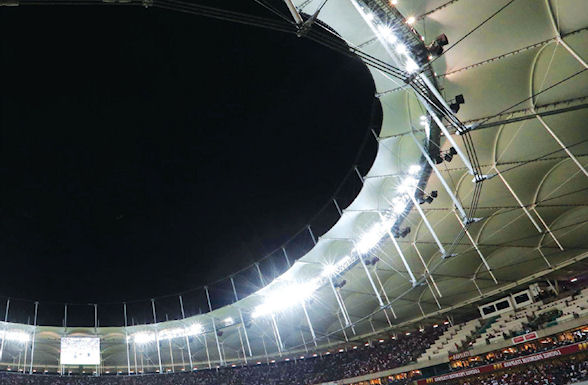
|
Matches
|
|
| 13 Jun | Spain v Netherlands |
| 16 Jun | Germany v Portugal |
| 20 Jun | Switzerland v France |
| 25 Jun | Bosnia-Herzegovina v Iran |
| 01 Jul | Round of 16 – 1H v 2G |
| 05 Jul | Quarter-final – W51 v W52 |
Estãdio Beira-Rio
Porto Alegre
Located alongside the Guaiba River, Estãdio Beira-Rio is also Brazil’s southernmost World Cup venue. Until recently a totally open-air stadium with just a few rows of concrete steps on one side and two small tiers of seats on the other, it has undergone arguably the most remarkable transformation of all the venues with a large, modern roof having been built to cover the stands. Estãdio Beira-Rio is the home ground of FC Internacional and it was the club, thanks in part to the support of their fans, that paid for the stadium’s upgrade.

|
Matches
|
|
| 15 Jun | France v Honduras |
| 18 Jun | Australia v Netherlands |
| 22 Jun | Korea Republic v Algeria |
| 25 Jun | Nigeria v Argentina |
| 30 Jun | Round of 16 – 1G v 2H |
Arena Pernambuco
Recife
The spectacular Arena Pernambuco was custom-built for the 2014 World Cup and with its ultra-modern façade that lights up in red at night, it will be hard to miss. Although Recife already had three football stadiums, Arena Pernambuco (Recife’s fourth stadium) is considered to be a vital piece of infrastructure for the city and is a hub of entertainment boasting 42 restaurants and bars. It also features a solar power plant which can not only fulfil the power needs of the stadium but meet the average consumption of 6,000 people.
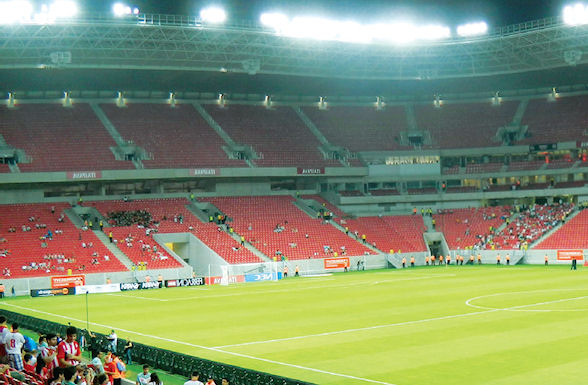
|
Matches
|
|
| 14 Jun | Côte d’Ivoire v Japan |
| 20 Jun | Italy v Costa Rica |
| 23 Jun | Croatia v Mexico |
| 26 Jun | USA v Germany |
| 29 Jun | Round of 16 – 1D v 2C |
Arena de Amazonia
Manaus
An intriguing stadium in an intriguing city, Manaus is located in the heart of the Amazon Rainforest with access usually by boat or plane. The stadium itself features a distinctive design with the main structure encased by a weaving metal frame designed to look like a straw basket. Arena de Amazonia is also eco-friendly, utilizing rainwater and solar power, but its construction has been plagued with problems. Already behind schedule at the time, a court ordered a halt to proceedings last December after a worker fell 35 metres to his death. It opened in early 2014 – almost a year later than initially planned.

|
Matches
|
|
| 14 Jun | England v Italy |
| 18 Jun | Cameroon v Croatia |
| 22 Jun | USA v Portugal |
| 25 Jun | Honduras v Switzerland |
Arena Pantanal
Cuiaba
Although the curse of Brazil’s World Cup stadiums struck Pantanal late last year when a fire roared through an underground area of the Arena, this newly built venue promises to look quite spectacular once it is fully operational – even if organizers are again leaving it a bit late. Echoing the region which is renowned for its flora and fauna, Arena Pantanal is fully sustainable and features a retractable roof which can close completely in bad weather.
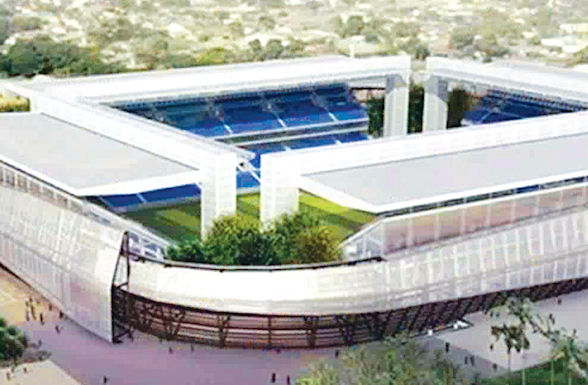
|
Matches
|
|
| 13 Jun | Chile v Australia |
| 17 Jun | Russia v Korea Republic |
| 21 Jun | Nigeria v Bosnia-Herzegovina |
| 24 Jun | Japan v Colombia |
Arena das Dunas
Natal
One of the smallest stadiums at this World Cup with a capacity of 42,000, Arena das Dunas was built on the site of the old Estadio Machadao which didn’t meet FIFA requirements and was demolished in 2011. Arena das Dunas is probably the most artistic of all the new stadiums with the roof made up of 20 petal-shaped modules designed to imitate the region’s many sand dunes. They also allow more sunlight and ventilation throughout the stadium.

|
Matches
|
|
| 13 Jun | Mexico v Cameroon |
| 16 Jun | Ghana v USA |
| 19 Jun | Japan v Greece |
| 24 Jun | Italy v Uruguay |
Arena da Baixada
Curitiba
It was almost dumped by FIFA as a World Cup venue after a labor tribunal ordered renovation work to be suspended due to safety breaches in October, but having since been given the green light the race is now on to ensure Arena da Baixada is finished in time. Ironically, having previously been upgraded in 1999, the stadium was already considered one of the most modern in Brazil and it came as no surprise when it was selected as one of the 12 World Cup venues. Nevertheless, more work began in 2012 to increase the capacity to 40,000 and install a retractable roof. The stadium is owned and operated by Brazilian Serie A club Atletico Paranaense.
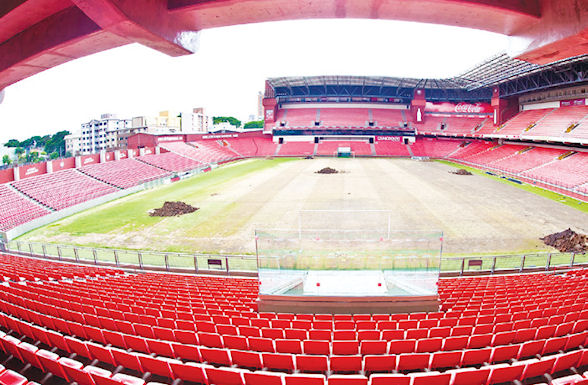
|
Matches
|
|
| 16 Jun | Iran v Nigeria |
| 20 Jun | Honduras v Ecuador |
| 23 Jun | Australia v Spain |
| 26 Jun | Algeria v Russia |

